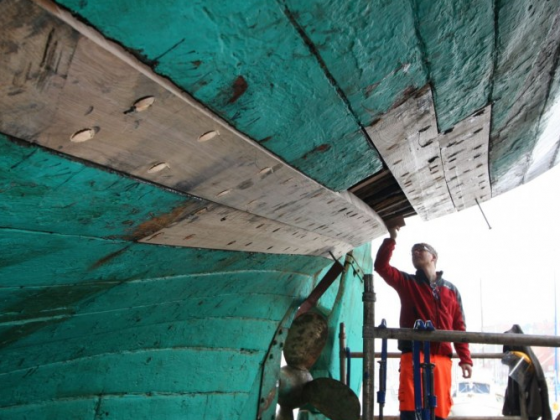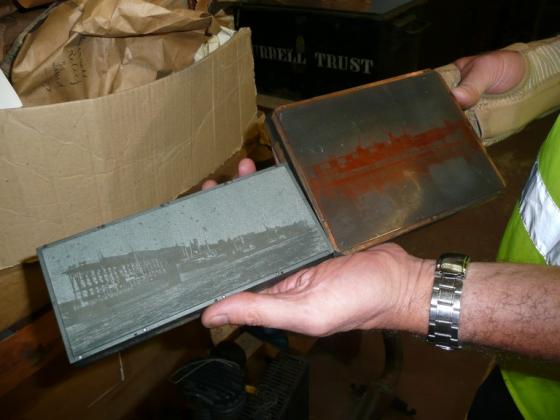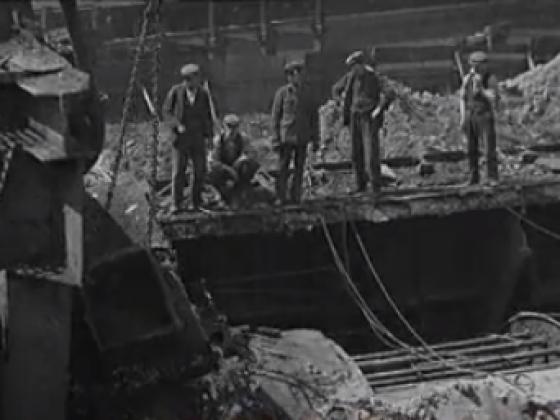.png) The town of Blyth in Northumberland gets its name from the river running through it. The port has been an important trading post since medieval times, but much of the town’s history dates back to its flourishing coal mining, fishing, salt trade and shipbuilding industries in the eighteenth century.
The town of Blyth in Northumberland gets its name from the river running through it. The port has been an important trading post since medieval times, but much of the town’s history dates back to its flourishing coal mining, fishing, salt trade and shipbuilding industries in the eighteenth century.
The image to the right shows the port in about 1827 (courtesy of Port of Blyth).
Although shipbuilding can be dated back to 1748, in the 20th century the industry became a significant factor in the running of the port.
The impact of war
The Blyth Shipbuilding and Dry Docks Company existed since 1883, but began to flourish during World War One when the British Admiralty requested: a seaplane carrier; nine tramps and colliers; ten X-lighter landing craft; and six sloops (or 'minesweepers') for the Royal Navy.
There was then a short slump in industry until the Second World War (see Depression), when orders once again picked up. One ship, the Audacity, was an escort carrier converted from an old German cargo ship.


Despite the obvious disruption that World War One and Two brought to the country as a whole, both wars provided ship yards with stability and prosperity.
But by the 1960s, things were quite different.
Economic decline
In 1966 Blyth Shipbuilding Company, one of the largest in the North East, closed during the economic difficulties. Around the same time, near to 30 other shipyards closed throughout the region because there were fewer orders coming in and improved competition from overseas.
Sustaining the port was made even more difficult in Blyth because the River Blyth is not a natural river. Rather, it is a big 'sump' and needs continuous continuous dredging to keep the depth. This was a costly process which required additional equipment and manpower.
Billy Whinnie worked as a dredger in the 1980s, tasked with maintaining the depth of the river. He explains in this clip that dredging provided a whole line of work in itself.
The Port of Blyth has a collection of oral history interviews with people who were connected to the work of the port. We have included links to some of these below.
Shipbreaking
The Hughes Bolckow Shipbreaking Company operated in Blyth from 1912 until the early 1980s. Shipbreaking involved dismantling ships, using a process that was almost the reverse of building them.
High quality building materials were often used in ships, so these were very valuable: the company had a furniture division that used the recycled wood from masts and decking. Blyth became known for its good quality joinery and woodwork in the 1960s and 1970s. A link below will take you to a film about shipbreaking made in the 1930s.

Regeneration and celebrating heritage
(External link)
In 1956 the town hosted the first Tall Ships race, and this is now an event celebrated each year in different cities around the North Sea.
The Blyth Tall Ship organisations runs a workshop teaching traditional shipbuilding skills, and encouraging tourism.
Watch the film below about the impact of the Tall Ships on Blyth.
The 21st century has seen a major refurbishment in Blyth as a whole, including the additions of the Keel Row shopping centre, office buildings at the quayside and artwork created by local schools.
The Port of Blyth itself has also been regenerated, something you can learn more about by speaking to volunteers at the Blyth Boathouse visitor centre.

Blyth Boathouse
(External link)
Blyth's history of shipping is celebrated by the town’s heritage centre: the Blyth Boathouse.
It offers visitors a fascinating time line of the Port and ongoing temporary exhibitions. The Space is also available for community activities, functions, events and displays. The archive team meets every Tuesday between 9.30am and 4pm and they are always looking for people to get involved.

Joan Boon of Blyth, Cleaner and Tack Welder
(External link)
Although it was always a male-dominated industry, some female employees found careers in the port. Joan Boon, originally employed at the port as a cleaner, became a female tack welder in the 1960s. She earned £24 a week, which “was not bad in those days”.

Terry Boyd of Blyth, Plater
(External link)
In this audio clip, Terry Boyd talks about the changes he saw over many years working in the Blyth shipyard.

Andy Wilkinson of Blyth, Apprentice Joiner at Blyth Shipyard
(External link)
Oral history recording of Andy Wilkinson of Blyth, Northumberland, recalling his apprenticeship as a joiner in Blyth Shipyard, Blyth, Northumberland, between 1948-1953.

Eddie Cain of Blyth, Remembering the Closure of Blyth Shipyard
(External link)
Listen to Eddie Cain's interview about his time working in the Blyth Shipyard until its closure in the 1960s, courtesy of Port of Blyth Heritage.

Leslie Long of Blyth, Shipyard Worker during WW2
(External link)
You can listen to Leslie Long talking about his experiences of working at the port during World War Two.

New Ships from Old! (1932)
(External link)
This film from the 1930s shows shipbreaking in action. The narrator talks about the importance of taking the steel from the ships and re-using it.
